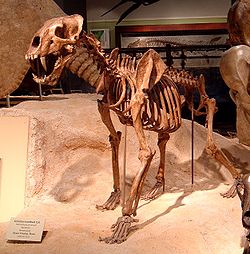ホモテリウム族
ホモテリウム族(ホモテリウムぞく、Homotherini)は、絶滅したネコ科マカイロドゥス亜科の肉食性哺乳類の族。俗に言う犬歯の伸びた剣歯虎のグループの1つであり、特に彼らはシミター・トゥースド・キャットとも呼ばれる。北アメリカ・ヨーロッパ・アジア・アフリカ・南アメリカに固有の生物であり[1]、約2300万年前の中新世から約1万2000年前の更新世にかけて生息していた[2]。
| ホモテリウム族 | |||||||||||||||||||||||||||||||||
|---|---|---|---|---|---|---|---|---|---|---|---|---|---|---|---|---|---|---|---|---|---|---|---|---|---|---|---|---|---|---|---|---|---|

| |||||||||||||||||||||||||||||||||
| 地質時代 | |||||||||||||||||||||||||||||||||
| 前期中新世–後期更新世 | |||||||||||||||||||||||||||||||||
| 分類 | |||||||||||||||||||||||||||||||||
| |||||||||||||||||||||||||||||||||
| 属 | |||||||||||||||||||||||||||||||||
形態
編集スミロドンやメガンテレオンといった頑強な体格をしたダーク・トゥースド・キャット(スミロドン族)と比較して、ホモテリウム族の上顎の犬歯は体サイズに対して小さかった。犬歯の縁は鋸歯状であった[3][4]。この犬歯の長さはホモテリウム族とスミロドン族共に体長と正の相関を示すが、剣歯虎でないネコ科動物は体長と犬歯の大きさの相関が遥かに小さいため、マカイロドゥス亜科とネコ亜科の犬歯は独立に進化したことが示唆されている[5]。
進化
編集化石から得られたミトコンドリアDNAシークエンスに基づくと、ホモテリウムの系統は約1800万年前にスミロドンの系統から派生したと見積もられている[6]。
長大な犬歯は植物食性の大型動物を狩るのに役立った。鋸歯状構造を持つ鋭い形状は倒した獲物の肉を切り裂くのに適していた。しかし、もしこの歯が不意に骨と接触すれば鋸歯が摩耗するばかりか歯自体が壊れた可能性さえもあり、そうなると食料を得られず餓死に至っていた[4][7]。
長大な犬歯(シミター型の歯とダーク型の歯の両方)がどのようにネコ科内あるいはそれ以前の哺乳類の系統で進化したかについては議論があり、この表現型の出現が性的二型に由来する、あるいは完全な自然選択によるという説が提唱されている。性的二型に由来するという見解では、メスを巡る争いのためにオスだけが持っていた長大な犬歯が、大型草食動物の出現によりメスにも有利な形質になったと説明されている[5]。自然選択側の見解では、大型草食動物に対する捕食者の生態的地位(ニッチ)を埋める生物が当時いなかったため、長大な犬歯が当該ニッチを埋めるのに優位に働いたと説明されている[8]。
分類
編集- ホモテリウム Homotherium Fabrini, 1890
- H. ischyrus
- H. latidens
- H. serum
- H. venezuelensis
- アンフィマカイロドゥス Amphimachairodus Kretzoi, 1929
- A. alvarezi
- A. coloradensis
- A. giganteus
- A. kabir
- A. kurteni
- ニムラヴィデス Nimravides Kitts 1958
- N. catacopsis
- N. galiani
- N. hibbardi
- N. pedionomus
- N. thinobates
- ゼノスミルス Xenosmilus Martin et al., 2000
- X. hodsonae
- ロコトゥンジャイルルス Lokotunjailurus Werdelin 2003
- L. emageritus
- L. fanonei
系統
編集ホモテリウム族の系統関係を以下のクラドグラムに示す[9][10][11][12][13]。
| ホモテリウム族 |
| |||||||||||||||||||||||||||||||||||||||||||||||||||||||||||||||||||||||||||
出典
編集- ^ Rincon, A.; Prevosti, F.; Parra, G. (2011). “New saber-toothed cat records (Felidae: Machairodontinae) for the Pleistocene of Venezuela, and the Great American Biotic Interchange”. Journal of Vertebrate Paleontology 31 (2): 468–478. doi:10.1080/02724634.2011.550366.
- ^ “†tribe Homotheriini Fabrini 1890 (cat)”. foosilworks. マッコーリー大学. 2020年8月22日閲覧。
- ^ Martin, L.D., (1989). Fossil history of the terrestrial Carnivora. In: Gittleman J.L., ed. Carnivore behaviour, ecology, and evolution, Vol. 1. Ithaca, IL: Cornell University Press, 536-568.
- ^ a b Van Valkenburgh, B (2007). “Deja vu: the evolution of feeding morphologies in the Carnivora”. Integrative and Comparative Biology 47: 147–163. doi:10.1093/icb/icm016. PMID 21672827.
- ^ a b Randau, M; C. Carbone; S. T. Turvey (2013). “Canine evolution in sabretoothed carnivores: natural selection or sexual selection?”. PLoS ONE 8. doi:10.1371/journal.pone.0072868.
- ^ Paijmans, J. L. A.; Barnett, R.; Gilbert, M. T. P.; Zepeda-Mendoza, M. L.; Reumer, J. W. F.; de Vos, J.; Zazula, G.; Nagel, D. et al. (2017-10-19). “Evolutionary History of Saber-Toothed Cats Based on Ancient Mitogenomics”. Current Biology 27: 3330–3336.e5. doi:10.1016/j.cub.2017.09.033. PMID 29056454.
- ^ Slater, G. J.; Valkenburgh, B. Van (2008). “Long in the tooth: evolution of sabertooth cat cranial shape”. Paleobiology 34: 403–419. doi:10.1666/07061.1.
- ^ Van Valkenburgh, B.; Sacco, T. (2002). “Sexual dimorphism, social behavior, and intrasexual competition in large Pleistocene carnivorans”. Journal of Vertebrate Paleontology 22: 164–169. doi:10.1671/0272-4634(2002)022[0164:sdsbai]2.0.co;2.
- ^ “Paleobiology Database”. 2012年3月25日時点のオリジナルよりアーカイブ。2011年6月16日閲覧。
- ^ Turner, Alan (1990). “The evolution of the guild of larger terrestrial carnivores during the Plio-Pleistocene in Africa”. Geobios 23 (3): 349–368. doi:10.1016/0016-6995(90)80006-2.
- ^ Martin, L. D.; Babiarz, J. P.; Naples, V. L.; Hearst, J. (2000). “Three Ways To Be a Saber-Toothed Cat”. Naturwissenschaften 87 (1): 41–44. Bibcode: 2000NW.....87...41M. doi:10.1007/s001140050007. PMID 10663132.
- ^ Turner, Alan (1997). The Big Cats and their fossil relatives. New York: Columbia University Press. p. 60. ISBN 978-0-231-10228-5
- ^ Wallace, S. C.; Hulbert, R. C. (2013). Larson, Greger. ed. “A New Machairodont from the Palmetto Fauna (Early Pliocene) of Florida, with Comments on the Origin of the Smilodontini (Mammalia, Carnivora, Felidae)”. PLoS ONE 8 (3): e56173. Bibcode: 2013PLoSO...856173W. doi:10.1371/journal.pone.0056173. PMC 3596359. PMID 23516394.